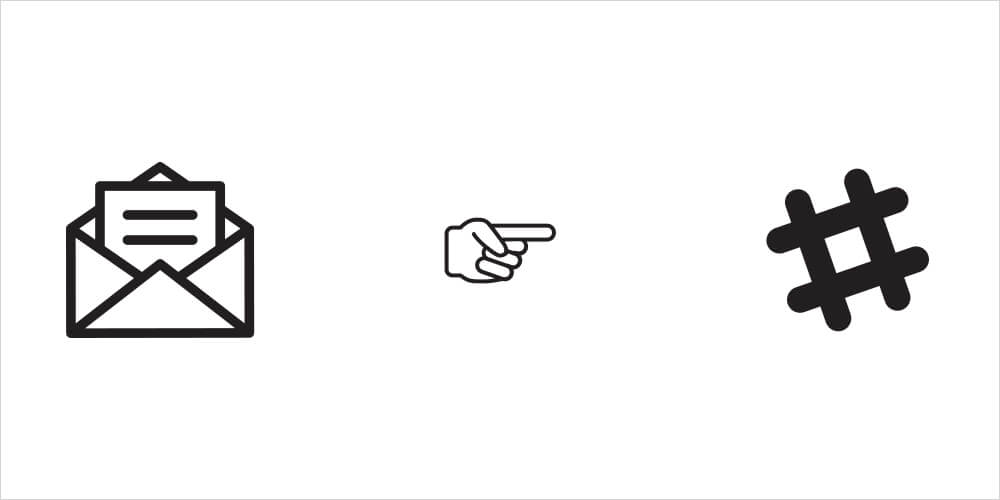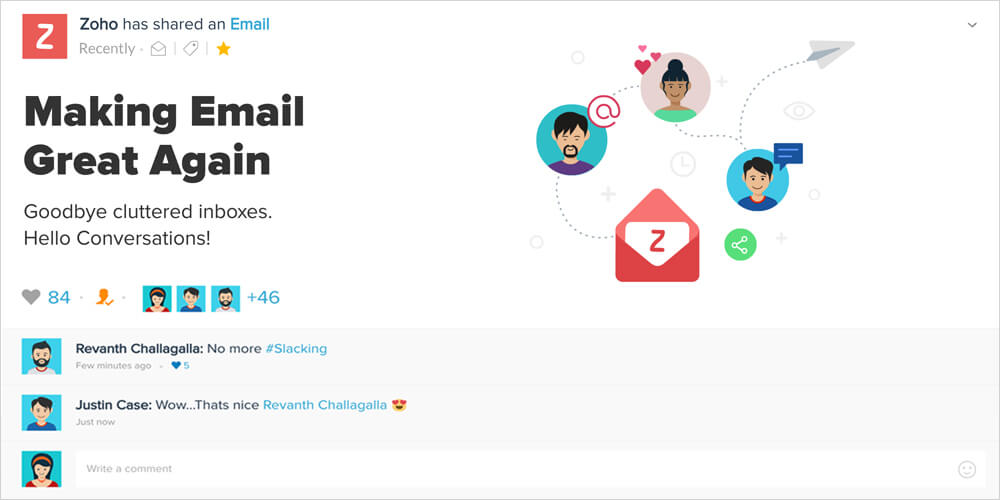Is there really a David to take down the Goliath of email, or do we just need to put old wine in a new bottle?
Improved . . .
The first step in solving any problem is recognizing there is one: Plain old email is not the best office collaboration tool anymore. It sure used to be. Then social media came along and changed the way we communicate. It’s instant, it’s fun and it’s easy. What’s not to like?
Yet email has been hanging on because no social media platform could make real inroads into the workplace. There seemed to be an unspoken consensus that you can’t mean business when you write on people’s walls or tweet at them. But at the same time, email started to feel tedious and drab (Fun fact: Email hasn’t really changed for half a century now).
Email might be more “adult” yet social feels so easy and intimate. People fire up social media apps on their smartphones to check for new updates without thinking, so instant messages are read sooner. You’re more likely to have second thoughts about checking your email, though. Businesses were quick to catch on to this new behavior, and social media started to overtake email when something required immediate attention. Leveraging social media’s most popular features into an office tool became inevitable.
Slack drew first blood. Merely positioning a chat-based app as a tool built exclusively for workplace collaboration was enough to open the floodgates of “RIP Email” obituaries. Even Facebook, which was meant for fun and catching up with friends, launched Workplace, a collaboration space for businesses. For quite a while now, pressure has been growing to put some zing into office communication. So 18 months ago, we went back to the drawing board. We had to re-invent email to address a fundamental challenge, “How do we keep people in their inboxes?”
For the business that runs off a browser.
Our idea: enable users to get more out of the inbox by removing the need to go anywhere else. Consequently, we built the Zoho Mail Suite: an inbox that also has Chat, Calendar, Notes, Tasks, and Contacts built in. That was phase one.
We then set out to fix email’s weaknesses. First up, scores of users complain about the pain of dealing with the overload of spam and unimportant emails. Consequently, we set out to reduce the number of emails users receive. When you really think about it, most workplace communication happens between people within the organization itself. It therefore makes practical sense to reserve emails exclusively for communication with people outside your organization.
With this key insight of separating internal and external communication, we devised a new communication tool meant exclusively for coworkers. We kept what’s best about email, while ensuring fewer emails get exchanged, while also bringing in the best of social media.
. . . and New
SaaS has truly changed the face of the modern workplace. With applications moving to the cloud, businesses practically run on a browser today. And we think one tab is always going to be open for your email inbox.
Here’s how our convictions about email’s endurance were vindicated.
Although Slack became wildly popular in very short time, cracks began to appear just as quickly. Could chat-based collaboration become the be-all and end-all of office communication? Towards the end of 2015, Slack announced an improved version of a feature called ‘Posts’ (You know it now as ‘Posts 2.0′). From their official blog, Slack explains the thinking behind this feature:
Sometimes you need to share an idea that requires a bit of explaining, or warrants an extended conversation. Slack messages are great for conversation, but if you have a big idea to share with your team, try the new Posts to lay out paragraph after glorious paragraph explaining it all. Posts retain the feature of being a standalone comment thread in channels where they are posted, so discussions about them stay organized.
Slack itself seemed to acknowledge the limitations of chat and instant messaging, the very cornerstone of their product that earned them diehard fans almost overnight. The real clincher though comes from an even earlier announcement :
Email remains ubiquitous and is quite useful for getting updates from pretty much every service on the Internet. Today we’re launching a new feature: all teams . . . can have email directed into Slack channels.
Even Slack couldn’t do away with email at their workplace, and they probably realized the same could well be the case with their users too. That, we think, speaks for itself.
We think an email-free workplace will never happen, and like the example of Slack shows, chat-only collaboration tools and the likes are not really there yet. As I argued before, workplaces need a communication tool that balances asynchronous collaboration and the best of social.
Ladies and gentlemen, we give you Streams.
Streams – A new way to interact with emails.
What we did was transform the way you interact with email. And “Email Sharing” was born. Share instead of replying or forwarding by simply @mentioning a recipient. Your colleague will receive a notification, and you can have productive discussions around the email you shared, and all the while there are fewer emails floating around in people’s inboxes.
Streams is a social hangout for your organization right inside your inbox, giving a fun spin to team collaboration and project management.
Just because you have to keep your inbox open all day at office, doesn’t necessarily mean you have to exchange a ton of emails. Collaboration with your co-workers can and should be simpler than composing ‘professional sounding’ emails, and cleaner than having an inbox full of outrageously long email threads. That’s why in Streams you can instead post a topic in your team’s group, and then discuss in the comment thread. It’s faster, easier and tidier all at the same time. Collaboration – check. Fewer emails – check. Game, set and match – Zoho Mail.
And this is just the beginning. We combined the best of email and social. The result is something a lot more than just an inbox. And that’s how you make email great again.

